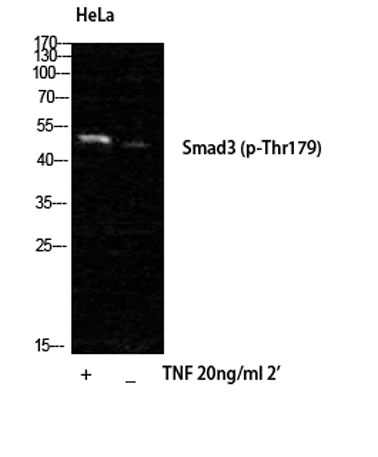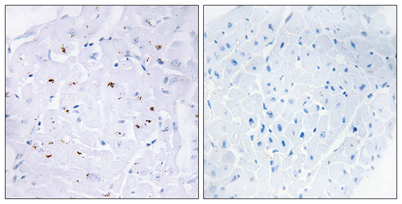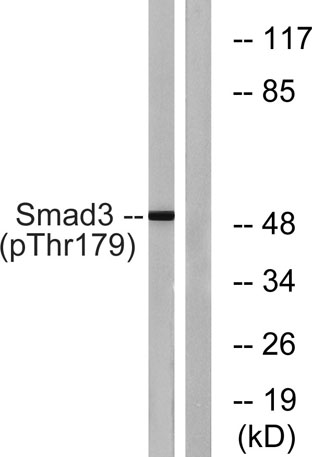








Smad3 (phospho Thr179) rabbit pAb
 One-click to copy product information
One-click to copy product information$148.00/50µL $248.00/100µL
| 50 µL | $148.00 |
| 100 µL | $248.00 |
Overview
| Product name: | Smad3 (phospho Thr179) rabbit pAb |
| Reactivity: | Human;Mouse;Rat |
| Alternative Names: | SMAD3; MADH3; Mothers against decapentaplegic homolog 3; MAD homolog 3; Mad3; Mothers against DPP homolog 3; hMAD-3; JV15-2; SMAD family member 3; SMAD 3; Smad3; hSMAD3 |
| Source: | Rabbit |
| Dilutions: | Western Blot: 1/500 - 1/2000. Immunohistochemistry: 1/100 - 1/300. ELISA: 1/10000. Not yet tested in other applications. |
| Immunogen: | The antiserum was produced against synthesized peptide derived from human Smad3 around the phosphorylation site of Thr179. AA range:145-194 |
| Storage: | -20°C/1 year |
| Clonality: | Polyclonal |
| Isotype: | IgG |
| Concentration: | 1 mg/ml |
| Observed Band: | 50kD |
| GeneID: | 4088 |
| Human Swiss-Prot No: | P84022 |
| Cellular localization: | Cytoplasm . Nucleus . Cytoplasmic and nuclear in the absence of TGF-beta. On TGF-beta stimulation, migrates to the nucleus when complexed with SMAD4 (PubMed:15799969, PubMed:21145499). Through the action of the phosphatase PPM1A, released from the SMAD2/SMAD4 complex, and exported out of the nucleus by interaction with RANBP1 (PubMed:16751101, PubMed:19289081). Co-localizes with LEMD3 at the nucleus inner membrane (PubMed:15601644). MAPK-mediated phosphorylation appears to have no effect on nuclear import (PubMed:19218245). PDPK1 prevents its nuclear translocation in response to TGF-beta (PubMed:17327236). Localized mainly to the nucleus in the early stages of embryo development with expression becoming evident in the cytoplasm of the inner cell mass at the blastocyst stage (By similarity) |
| Background: | The protein encoded by this gene belongs to the SMAD, a family of proteins similar to the gene products of the Drosophila gene 'mothers against decapentaplegic' (Mad) and the C. elegans gene Sma. SMAD proteins are signal transducers and transcriptional modulators that mediate multiple signaling pathways. This protein functions as a transcriptional modulator activated by transforming growth factor-beta and is thought to play a role in the regulation of carcinogenesis. [provided by RefSeq, Apr 2009], |
-
 Western Blot analysis of HELA cells using Phospho-Smad3 (T179) Polyclonal Antibody
Western Blot analysis of HELA cells using Phospho-Smad3 (T179) Polyclonal Antibody -
 Immunohistochemistry analysis of paraffin-embedded human heart, using Smad3 (Phospho-Thr179) Antibody. The picture on the right is blocked with the phospho peptide.
Immunohistochemistry analysis of paraffin-embedded human heart, using Smad3 (Phospho-Thr179) Antibody. The picture on the right is blocked with the phospho peptide. -
 Western blot analysis of lysates from HeLa cells treated with TNF 20ng/ml 2', using Smad3 (Phospho-Thr179) Antibody. The lane on the right is blocked with the phospho peptide.
Western blot analysis of lysates from HeLa cells treated with TNF 20ng/ml 2', using Smad3 (Phospho-Thr179) Antibody. The lane on the right is blocked with the phospho peptide.

 Manual
Manual